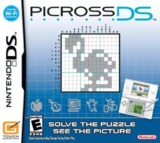Quite possibly the most addictive puzzle game on the DS, or game on the DS period.
Picross is another game that plays wonderfully thanks to the DS's touch screen. You tap the stylus on spaces you want to fill in as squares, and then you tap on the X icon to change your stylus function to mark spaces where squares cannot go. The puzzles start out as 5x5 grids, but once they become larger, you'll be given a couple of other icons that will allow you to zoom in and out, and then one that will allow you to move the grid around without affecting any of the spaces. You can also change the control scheme to use the d-pad and buttons, but honestly, there's no reason to play the game that way when you can use the stylus.
There's all sorts of modes that you can play in Picross. The main Picross mode is where the meat of the game is at. It's broken down into tutorials, Easy Mode, Normal Mode (which share the same rules) and Free Mode. Easy Mode has only 15 puzzles, but Normal Mode and Free Mode contain 11 levels, each level consisting of 15 puzzles. Normal Mode and Free Mode differ quite a bit. Firstly, every completed puzzle will treat you with an animation of the picture that puzzle represents. For both Easy and Normal modes, you'll be given a time limit of an hour to finish the puzzle. If you finish after time expires, you don't get the animation. You are also penalized for every wrong move you make. The first mistake adds two minutes, with the second and third mistakes adding four and eight minutes respectively.
Free Mode doesn't have any time limit. However, these puzzles are much harder to complete, as they don't inform you of any mistakes you've made. You won't know mistakes even exist until you find contradictions, and they usually show up pretty late, so it pays to make sure you know the moves you are making are correct. What Free Mode has that Normal Mode doesn't is Overlay. When you turn on Overlay (also knowns as Try It Out Mode), you are allowed to make temporary moves. If you're unsure where to go, turn on Overlay and make your choice. If you find that there are contradictions because of the path you've chosen, you can clear all your temporary moves. If everything fits, then you can apply the overlay and keep going - or in the instance where you filled in all the squares - solve the puzzle.
What I really like about Picross is that each level has a theme to it. In Normal Mode, they are all plants and animals. In Free Mode, they are all objects and people. The tiles of the grid will also have graphic and sound effects to go along with the themes. For instance, Level 6 of Normal Mode is insect themed, so all the tiles are leaves, and filling in squares makes the tiles disappear as if they're being eaten by insects. Level 2 of Free Mode is electronics themed, and the tiles are that of bubble wrap. Filling in squares causes them to pop. Perhaps my favorite level is Level 4 of Free Mode, which happens to be themed on musical instruments. The tiles are piano keys. When you fill in a square, it turns them from white to black, and when you X out a space, it puts a sharp note inside it. Each tap of the tiles are notes from Marry Had a Little Lamb, London Bridge is Falling Down, and Twinkle Twinkle Little Star. If you're so inclined, you can just tap in one spot over and over to play out the songs.
Also, Normal and Free Mode contain different music. Normal Mode has three different generic tracks of music. They are Jazz, Reggae and Bossa Nova. Free Mode contains Rock, House and Ambient. The tracks are easy listening, but you'll want to change it up for yourself from time to time, as they could drive you bonkers while staring at a puzzle for an hour. Other general modes of the game are My Picross, which allows you to make your own puzzles and share them with friends or download new puzzles via Wi-Fi ; and Daily Picross, which presents different puzzle challenges, such as solving puzzles with no mistakes, and solving puzzles by correcting pre-existing errors. It is a very safe bet to say that you won't find a DS game out there that contains more value than Picross. The initial offering of puzzles in the main Picross mode (combining Easy, Normal and Free modes) comes to 345 puzzles. Daily Picross will challenge you in different ways, while My Picross will let you play user made puzzles. New puzzle packs are also being made for download soon, so really, it's a never-ending game, and it's only 20 dollars. You just cannot go wrong with this game. If you have a DS and have the slightest interest in puzzle games, it's a must-have title. Hell, I'd even recommend people BUY a DS for this game if they don't already own one. To be quite honest, I'm surprised I was actually able to tear myself away from the game long enough to write this review!

